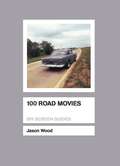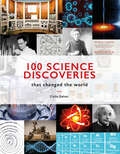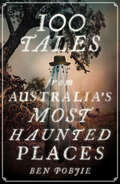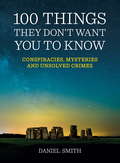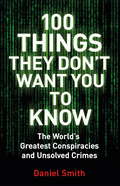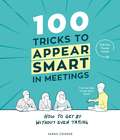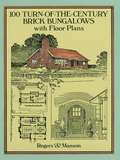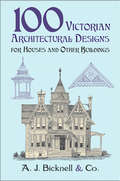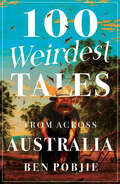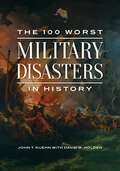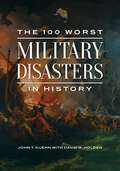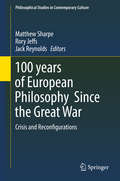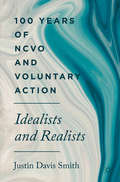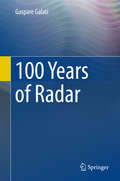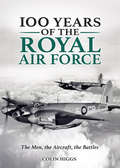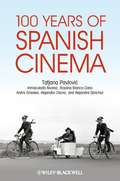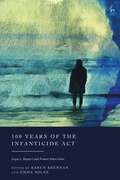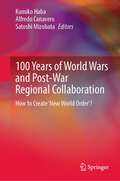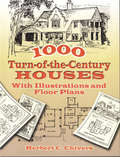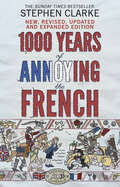- Table View
- List View
100 Road Movies (Screen Guides)
by Jason WoodIn '100 Road Movies', each entry will offer an insightful critique in terms of aesthetics, plot structure and defining formal and thematic features, whilst also considering the title in the wider context and understanding of by what criteria a film may be considered a road movie. Full credits, including year of production, principal cast and technical crew and country of origin will also be included at the foot of each entry. There will be a selection of illustrative stills, approximately twenty-five in total. The scope is broad, a consideration of the elements that gave rise to the road movie sub-genre, how this sub-genre corresponds to other traditional genres (the thriller, the western etc) and how various international countries have adopted the road movie to reflect their cultural, social, political and geographical identities.
100 Science Discoveries That Changed the World
by Colin SalterArranged in chronological order from the early Greek mathematicians, Euclid and Archimedes through to present-day Nobel Prize winners, 100 Science Discoveries That Changed the World charts the great breakthroughs in scientific understanding.
100 Shakespeare Films (Screen Guides)
by Daniel RosenthalFrom Oscar-winning British classics to Hollywood musicals and Westerns, from Soviet epics to Bollywood thrillers, Shakespeare has inspired an almost infinite variety of films. Directors as diverse as Orson Welles, Akira Kurosawa, Franco Zeffirelli, Kenneth Branagh, Baz Luhrmann and Julie Taymor have transferred Shakespeare's plays from stage to screen with unforgettable results. Spanning a century of cinema, from a silent short of 'The Tempest' (1907) to Kenneth Branagh's 'As You Like It' (2006), Daniel Rosenthal's up-to-date selection takes in the most important, inventive and unusual Shakespeare films ever made. Half are British and American productions that retain Shakespeare's language, including key works such as Olivier's 'Henry V' and 'Hamlet', Welles' 'Othello' and 'Chimes at Midnight', Branagh's 'Henry V' and 'Hamlet', Luhrmann's 'Romeo + Juliet' and Taymor's 'Titus'. Alongside these original-text films are more than 30 genre adaptations: titles that aim for a wider audience by using modernized dialogue and settings and customizing Shakespeare's plots and characters, transforming 'Macbeth' into a pistol-packing gangster ('Joe Macbeth' and 'Maqbool') or reimagining 'Othello' as a jazz musician ('All Night Long'). There are Shakesepeare-based Westerns ('Broken Lance', 'King of Texas'), musicals ('West Side Story', 'Kiss Me Kate'), high-school comedies ('10 Things I Hate About You', 'She's the Man'), even a sci-fi adventure ('Forbidden Planet'). There are also films dominated by the performance of a Shakespearean play ('In the Bleak Midwinter', 'Shakespeare in Love'). Rosenthal emphasises the global nature of Shakespearean cinema, with entries on more than 20 foreign-language titles, including Kurosawa's 'Throne of Blood and Ran', Grigori Kozintsev's 'Russian Hamlet' and 'King Lear', and little-known features from as far afield as 'Madagascar' and 'Venezuela', some never released in Britain or the US. He considers the films' production and box-office history and examines the film-makers' key interpretive decisions in comparison to their Shakespearean sources, focusing on cinematography, landscape, music, performance, production design, textual alterations and omissions. As cinema plays an increasingly important role in the study of Shakespeare at schools and universities, this is a wide-ranging, entertaining and accessible guide for Shakespeare teachers, students and enthusiasts.
100 Shakespeare Films (Screen Guides)
by Daniel RosenthalFrom Oscar-winning British classics to Hollywood musicals and Westerns, from Soviet epics to Bollywood thrillers, Shakespeare has inspired an almost infinite variety of films. Directors as diverse as Orson Welles, Akira Kurosawa, Franco Zeffirelli, Kenneth Branagh, Baz Luhrmann and Julie Taymor have transferred Shakespeare's plays from stage to screen with unforgettable results. Spanning a century of cinema, from a silent short of 'The Tempest' (1907) to Kenneth Branagh's 'As You Like It' (2006), Daniel Rosenthal's up-to-date selection takes in the most important, inventive and unusual Shakespeare films ever made. Half are British and American productions that retain Shakespeare's language, including key works such as Olivier's 'Henry V' and 'Hamlet', Welles' 'Othello' and 'Chimes at Midnight', Branagh's 'Henry V' and 'Hamlet', Luhrmann's 'Romeo + Juliet' and Taymor's 'Titus'. Alongside these original-text films are more than 30 genre adaptations: titles that aim for a wider audience by using modernized dialogue and settings and customizing Shakespeare's plots and characters, transforming 'Macbeth' into a pistol-packing gangster ('Joe Macbeth' and 'Maqbool') or reimagining 'Othello' as a jazz musician ('All Night Long'). There are Shakesepeare-based Westerns ('Broken Lance', 'King of Texas'), musicals ('West Side Story', 'Kiss Me Kate'), high-school comedies ('10 Things I Hate About You', 'She's the Man'), even a sci-fi adventure ('Forbidden Planet'). There are also films dominated by the performance of a Shakespearean play ('In the Bleak Midwinter', 'Shakespeare in Love'). Rosenthal emphasises the global nature of Shakespearean cinema, with entries on more than 20 foreign-language titles, including Kurosawa's 'Throne of Blood and Ran', Grigori Kozintsev's 'Russian Hamlet' and 'King Lear', and little-known features from as far afield as 'Madagascar' and 'Venezuela', some never released in Britain or the US. He considers the films' production and box-office history and examines the film-makers' key interpretive decisions in comparison to their Shakespearean sources, focusing on cinematography, landscape, music, performance, production design, textual alterations and omissions. As cinema plays an increasingly important role in the study of Shakespeare at schools and universities, this is a wide-ranging, entertaining and accessible guide for Shakespeare teachers, students and enthusiasts.
100 Tales from Australia's Most Haunted Places
by Ben PobjieFrom the ghostly black horse of Sutton Forest to the butcher of Adelaide Street, a haunted Brisbane lift to the chilling experiments carried out by Doctor Blood of the North Kapunda Hotel, Australia abounds in spooky stories that are all unnervingly based in fact and tied to real places you can visit or avoid. In 100 Tales from Australia's Most Haunted Places, comedy writer and general scaredy-cat Ben Pobjie communes with the spirit world to send a shiver down your spine. A book best read with the light left on.
100 Things They Don't Want You To Know: Conspiracies, mysteries and unsolved crimes (100 Things)
by Daniel SmithWho was the Mothman? What caused the death of the Bordens? Did Lee Harvey Oswald assassinate JFK? And what was the true meaning of the 'WOW' signal? Daniel Smith, author of 100 Places You Will Never Visit, sets out to uncover the truth behind 100 unexplained events that have been shrouded in secrecy for generations. Under his investigative searchlight are mysterious landmarks, disappearances at sea, legendary myths, astonishing coincidences, UFOs, missing people and bizarre natural phenomena. Ranging from suspicious deaths (The Black Dahlia) to notorious murderers (Jack the Ripper) and from ancient artefacts (Tarim Mummies) to Cold War cover-ups (Lost Cosmonauts), via documents that remain untranslatable (Voynich Manuscript), debated icons of religion (Shroud of Turin) and puzzling paranormal appearances (Marfa Lights), Daniel Smith leaves no stone unturned in his quest to expose the bare facts and unravel the tales that have gripped curious minds for years. Also includes: Spontaneous Combustion, Whereabouts of Nazi Gold, Red Rain, Lost Literature of the Mayan Civilisation, Disappearance of Jean Spangler, Severed Feet of British Columbia, Shakespeare's Dark Lady, The Shugborough Inscription, Stonehenge, The Flying Dutchman, Lewis Carroll's Lost Diaries and the Beast of Bodmin Moor.
100 Things They Don't Want You To Know: Conspiracies, mysteries and unsolved crimes (100 Things)
by Daniel SmithTHE TRUTH IS OUT THERE . . . Who was Jack the Ripper? Where did the Nazis stash their gold? Who are the real Men in Black? Did aliens send the 'WOW' signal? And how will the world end? 100 Things They Don't Want You to Know sets out to uncover the truth behind the world's most mysterious cover-ups and unexplained events that have been shrouded in secrecy for generations. From suspicious deaths and disappearances to enigmatic identities, from Cold War cover-ups to puzzling paranormal phenomena and from ancient artefacts to coded documents, 100 Things They Don't Want You to Know takes you on a quest to solve the greatest mysteries, strange disappearances, suspicious cover-ups and conspiracy theories.Including: Black Dahlia, the Marfa Lights, the Turin Shroud, Spontaneous Combustion, Lost Literature of the Mayan Civilisation, Disappearance of Jean Spangler, Shakespeare's True Identity, the Turin Shroud, the Easter Island Glyphs, the Death of Lee Harvey Oswald, the Mothman, The Flying Dutchman, the Secret Mission of Ruldolph Hess, the 'WOW" signal, Lewis Carroll's Lost Diaries, the Man in the Iron Mask and the Beast of Bodmin Moor.
100 Tricks to Appear Smart In Meetings: How To Get By Without Even Trying
by Sarah CooperThe book that’s missing from 55 million offices and conference rooms around the world: the idiot’s guide to the idiot’s guide to conquering the corporate meeting. In it you will learn the essential subtle tricks that pay big dividends by making you look really clever in meetings: constant nodding, pretend concentration, useless rhetorical questions, how to nail the big presentation by pacing and getting someone else to control your slides. Complete with illustrated tips, examples, and scenarios, Sarah Cooper's 100 Tricks to Appear Smart in Meetings gives you actionable ways to use words like 'actionable', in order to sound smart.
100 Turn-of-the-Century Brick Bungalows with Floor Plans
by Rogers MansonWhen Brickbuilder, an early 20th-century trade publication, sponsored a major nationwide competition for bungalow designs, over 600 drawings were submitted by architects and draftsmen from around the country. This book, reprinted from a rare catalog published in 1912, contains the 100 winning entries from that event. The competition had two important criteria: the principal construction material was to be brick, and the complete cost -- exclusive of the land -- would be about $3,000.The winning designs came from all over the United States and reflected a diverse range of tastes and styles -- from a single-floor, tile-roof hacienda to an elaborate thatched-roof English cottage, complete with decorative brickwork and a semicircular exterior wall. Each of the 100 superbly rendered plates shows the house in perspective and provides floor plans, some landscape planning, and an itemized list of construction costs.An essential reference book for restorers of period homes, historians, students, and enthusiasts of American domestic architecture, this fascinating book also offers browsers an entertaining glimpse of houses that still appear in countless areas across the country.
100 Victorian Architectural Designs for Houses and Other Buildings (Dover Architecture)
by A. J. Bicknell Co.Originally published in 1878, this now-rare collection of designs supplies views of a remarkable variety of modestly priced structures: houses, villas, cottages, many others. Handsome drawings of perspective views and elevations, some of which include floor plans, plus suggestions for interior design. 98 black-and-white illustrations.
100 Weirdest Tales from Across Australia
by Ben PobjieTales of the strange, unnerving and downright bizarre from one of the weirdest places on EarthFish falling out of the sky, joggers relieving themselves on your doorstep, mysterious monsters constantly springing from the shadows, spooky lights and ill-conceived toast spreads: these are just some of the things you can expect on any given day in our surreal southern land.In 100 Weirdest Tales from Across Australia, comedy writer and accredited weirdness expert Ben Pobjie delves deep into Australia's past and present to serve up the weirdest stories of all, which will leave you smacking your gob with one hand while scratching your head with the other.
100 Westerns (Screen Guides)
by Edward BuscombeAddresses the perennial appeal of the Western, exploring its 19th century popular culture, and its relationship to the economic structure of Hollywood. This work considers the defining features of the Western and traces its main cycles, from the epic Westerns of the 1920s and singing cowboys of the 1930s to the Spaghetti Westerns of the 1960s.
100 Westerns (Screen Guides)
by Edward BuscombeAddresses the perennial appeal of the Western, exploring its 19th century popular culture, and its relationship to the economic structure of Hollywood. This work considers the defining features of the Western and traces its main cycles, from the epic Westerns of the 1920s and singing cowboys of the 1930s to the Spaghetti Westerns of the 1960s.
The 100 Worst Military Disasters in History
by John T. KuehnThe 100 Worst Military Disasters in History is a fascinating collection that educators, students, and historians will all find useful in helping them understand the causes and consequences of the most infamous military failures in history.The dynamics of military disaster are equally, if not more, important as understanding how to achieve success on the battlefield. This comprehensive book covers the complete gamut of human history as it tells the compelling stories of the worst military debacles of all time. It covers battles, campaigns, and wars, starting with the ancient Persians and Greeks and finishing with the U.S. conflicts in Afghanistan and Iraq. Not limited to land warfare, however, the book also includes a number of the most disastrous naval engagements and campaigns in world history.The 100 Worst Military Disasters in History opens with a detailed introduction illuminating the role military strategy and politics played in some of the worst battlefield failures throughout history. The entries are augmented with several engaging sidebars related to various military disasters. This eclectic collection includes coverage of many lesser known military disasters such as the Taiping Rebellion, during which 20 times more Chinese died than the number of people killed in the American Civil War.
The 100 Worst Military Disasters in History
by John T. KuehnThe 100 Worst Military Disasters in History is a fascinating collection that educators, students, and historians will all find useful in helping them understand the causes and consequences of the most infamous military failures in history.The dynamics of military disaster are equally, if not more, important as understanding how to achieve success on the battlefield. This comprehensive book covers the complete gamut of human history as it tells the compelling stories of the worst military debacles of all time. It covers battles, campaigns, and wars, starting with the ancient Persians and Greeks and finishing with the U.S. conflicts in Afghanistan and Iraq. Not limited to land warfare, however, the book also includes a number of the most disastrous naval engagements and campaigns in world history.The 100 Worst Military Disasters in History opens with a detailed introduction illuminating the role military strategy and politics played in some of the worst battlefield failures throughout history. The entries are augmented with several engaging sidebars related to various military disasters. This eclectic collection includes coverage of many lesser known military disasters such as the Taiping Rebellion, during which 20 times more Chinese died than the number of people killed in the American Civil War.
100 years of European Philosophy Since the Great War: Crisis and Reconfigurations (Philosophical Studies in Contemporary Culture #25)
by Matthew Sharpe Rory Jeffs Jack ReynoldsThis book is a collection of specifically commissioned articles on the key continental European philosophical movements since 1914. It shows how each of these bodies of thought has been shaped by their responses to the horrors set in train by World War I, and considers whether we are yet ‘post-post-war’. The outbreak of World War I in August 1914,set in chain a series of crises and re-configurations, which have continued to shape the world for a century: industrialized slaughter, the end of colonialism and European empires, the rise of the USA, economic crises, fascism, Soviet Marxism, the gulags and the Shoah. Nearly all of the major movements in European thinking (phenomenology, psychoanalysis, Hegelianism, Marxism, political theology, critical theory and neoliberalism) were forged in, or shaped by, attempts to come to terms with the global trauma of the World Wars. This is the first book to describe the development of these movements after World War I, and as such promises to be of interest to philosophers and historians of philosophy around the world.
100 Years of NCVO and Voluntary Action: Idealists and Realists
by Justin Davis SmithThis book explores the rich history of voluntary action in the United Kingdom over the past 100 years, through the lens of the National Council for Voluntary Organisations (NCVO), which celebrates its centenary in 2019. From its establishment at the end of the First World War, through the creation of the Welfare State in the middle of the twentieth century, to New Labour and the Big Society at the beginning of this century, NCVO has been at the forefront of major developments within society and the voluntary movement. The book examines its many successes, including its role in establishing high-profile charities such as Age Concern, the Youth Hostels Association, and National Association of Citizens’ Advice Bureaux. It charts the development of closer relations with the state, resulting in growing awareness of the value of voluntary action, increased funding, and beneficial changes to public policy, tax and charity law. But it also explores the criticisms NCVO has faced, in particular that by pursuing a partnership agenda and championing professionalisation, it has contributed to an erosion of the movement’s independence and distinctiveness.
100 Years of Radar
by Gaspare GalatiThis book offers fascinating insights into the key technical and scientific developments in the history of radar, from the first patent, taken out by Hülsmeyer in 1904, through to the present day. Landmark events are highlighted and fascinating insights provided into the exceptional people who made possible the progress in the field, including the scientists and technologists who worked independently and under strict secrecy in various countries across the world in the 1930s and the big businessmen who played an important role after World War II. The book encourages multiple levels of reading. The author is a leading radar researcher who is ideally placed to offer a technical/scientific perspective as well as a historical one. He has taken care to structure and write the book in such a way as to appeal to both non-specialists and experts. The book is not sponsored by any company or body, either formally or informally, and is therefore entirely unbiased. The text is enriched by approximately three hundred images, most of which are original and have been accessed by detailed searches in the archives.
100 Years of The Royal Air Force: The Men, The Aircraft, The Battles
by Colin HiggsThe Royal Air Force has been central to the evolution of air power for 100 years. It is also the oldest independent air force in the world with origins that take it back to the earliest days of flight. Formed in 1918 while the outcome of the First World War was still in doubt the Royal Air Force has played a vital part in the defence of Britain and her allies for a century. 100 Years of the Royal Air Force is a fast-paced and authoritative account of the history, the aeroplanes, the technology and the people who have flown and fought for the service and it is illustrated with more than 150 great images from a wide variety of sources. It tells of the early days when the RAF was formed from the merger of the RFC and the RNAS; the fight to stay independent in the inter-war years; the vitally important battles fought during the Second World War - the Battle of Britain, the bomber campaign, Coastal Command s fight to maintain Britain s sealanes and the tireless work of Transport Command. The coming of jet aircraft revolutionised the work of the RAF as did the advent of flight refuelling, the missile and many other key inventions. The modern Royal Air Force, now smaller and constrained by budgets, has maintained its reputation as an agile, adaptable and capable force.
100 Years of Spanish Cinema
by Tatjana Pavlović Inmaculada Alvarez Rosana Blanco-Cano Anitra Grisales Alejandra Osorio Alejandra Sánchez100 Years of Spanish Cinema provides an in-depth look at the most important movements, films, and directors of twentieth-century Spain from the silent era to the present day. A glossary of film terms provides definitions of essential technical, aesthetic, and historical terms Features a visual portfolio illustrating key points of many of the films analyzed Includes a clear, concise timeline to help students quickly place films and genres in Spain’s political, economical, and historical contexts Discusses over 20 films including Amor Que Mata, Un Chien Andalou, Viridana, El Verdugo, El Crimen de Cuenca, and Pepi, Luci, Born
100 Years of the Infanticide Act: Legacy, Impact and Future Directions
by Karen Brennan and Emma MilneThis book provides the first comprehensive and detailed analysis of the Infanticide Act and its impact in England and Wales and around the world.It is 100 years since an Infanticide Act was first passed in England and Wales. The statute, re-enacted in 1938, allows for leniency to be given to women who kill their infants within the first year of life. This legislation is unique and controversial: it creates a specific offence and defence that is available only to women who kill their biological infants. Men and other carers are not able to avail of the special mitigation provided by the Act, nor are women who kill older children.The collection brings together leading experts in the field to offer important insights into the history of the law, how it works today, the impact and legacy of the statute and potential futures of infanticide laws around the world.Contributors consider the Act in practice in England and Wales, the ways it has been portrayed in the British media and justifications for and criticisms of the provision of special treatment for women who kill their infants within a year of birth.It also looks at the criminal justice responses to infanticide in other jurisdictions, such as Australia, Ireland, Sweden and the United States of America.
100 Years of the Infanticide Act: Legacy, Impact and Future Directions
This book provides the first comprehensive and detailed analysis of the Infanticide Act and its impact in England and Wales and around the world.It is 100 years since an Infanticide Act was first passed in England and Wales. The statute, re-enacted in 1938, allows for leniency to be given to women who kill their infants within the first year of life. This legislation is unique and controversial: it creates a specific offence and defence that is available only to women who kill their biological infants. Men and other carers are not able to avail of the special mitigation provided by the Act, nor are women who kill older children.The collection brings together leading experts in the field to offer important insights into the history of the law, how it works today, the impact and legacy of the statute and potential futures of infanticide laws around the world.Contributors consider the Act in practice in England and Wales, the ways it has been portrayed in the British media and justifications for and criticisms of the provision of special treatment for women who kill their infants within a year of birth.It also looks at the criminal justice responses to infanticide in other jurisdictions, such as Australia, Ireland, Sweden and the United States of America.
100 Years of World Wars and Post-War Regional Collaboration: How to Create 'New World Order'?
by Kumiko Haba Alfredo Canavero Satoshi MizobataThis book is about the 100 years of World Wars and Regional Collaboration in the twentieth and twenty-first centuries, investigating and considering how to foster Good Governance and New World Order. The world is currently at the historical turning point. The twentieth century witnessed two World Wars (WWI and WWII), followed by the Cold War that dominated geopolitics. Amidst the post-war devastation, the European Community, soon succeeded by the European Union, came into being. Peaceful governance was nurtured by building economic collaboration and institutions and by establishing liberalism, democracy and the rule of law. In Asia, the Association of Southeast Asian Nations (ASEAN) also pursued regional governance after WWII, but in East Asia, the American Divide and Rule policy is continuing until now by the influence of China, North Korea and Russia. In the contemporary world in the twenty-first century, a new nationalism, Populism and Authoritarianism are spreading. At the same time, a wave of rapid economic growth is occurring in developing countries, especially in China and India. Destabilization is spreading in East Asia, Southeast Asia, and South Asia concurrently with the search for “Democratization”. Through the two World Wars and the Cold War which originated in 100 years of the twentieth century, what types of regional institutions and governance have been developed to avoid endless wars and conflicts? In this book, it is examined, what kind of order is necessary to stabilize the regions from conflicts and wars in both Europe and Asia. The themes of the Tokyo Conferences and the Kyoto Conference by SCJ (Science Council of Japan) in December 2020, were investigated and clarified, how the countries that were caught up in global wars have considered regional coexistence in each period, and how to establish peace, stability, and prosperity by means of new institutionalizations, norms and the rule of law. The aim of the authors is to examine and discuss How to create New World Order, Regional Collaborations and Good Governance in the historical power transition period. This book can inspire many scholars and young researchers to join in discussing how to create New World Order in the twenty-first century, from the midst of the unstable situations of the global geopolitics.
1000 Turn-of-the-Century Houses: With Illustrations and Floor Plans
by Herbert C. ChiversA remarkable presentation of the "finished ideas of a practicing architect of high rank in his profession," this early-twentieth-century showcase of homes features a wide range of designs from a Midwest master. Reproduced from a rare edition, the work features a splendid array of dwellings, from cottages and bungalows to sprawling mansions. Each house is meticulously illustrated and accompanied by complete floor plans."A poorly planned house is usually more expensive than a modern practical plan," according to the author, architect Herbert C. Chivers. Combining "modern methods" with attractive but modestly priced plans, Chivers promoted his business with sketches of stylish homes, accompanied by brief captions stating dimensions, prices, and occasional suggestions for modifications. This reprint of his complete guide to domestic architecture of the early 1900s constitutes a valuable resource for home hobbyists, architecture students and professionals, as well as antique collectors.
1000 Years of Annoying the French
by Stephen ClarkeNEW UPDATED EDITION Was the Battle of Hastings a French victory?Non! William the Conqueror was Norman and hated the French.Were the Brits really responsible for the death of Joan of Arc?Non! The French sentenced her to death for wearing trousers.Did the French write "God Save the Queen"?Non! But that's what they claim.Ten centuries' worth of French historical 'facts' bite the dust as Stephen Clarke looks at what has really been going on since 1066 ...Featuring new annoyances – both historical and recent – inflicted on the French, including Napoleon's "banned" chamber pot, Louis XIV's painful operation, Anglo-French jibes during the 2012 London Olympics, French niggles about William and Kate's royal wedding, and much more ...
